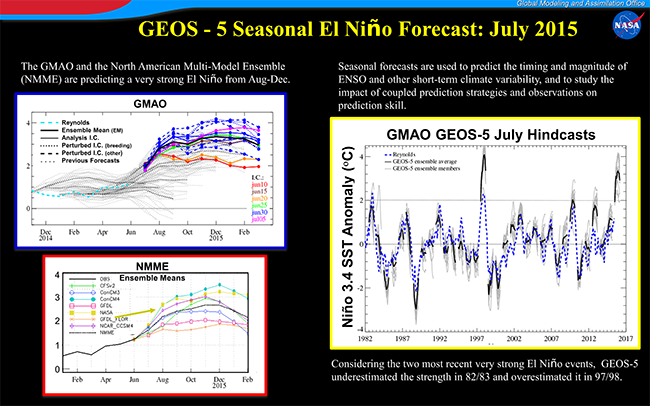GEOS - 5 Seasonal El Niño Forecast: July 2015
Seasonal-to-Interannual coupled forecasts are conducted on an experimental basis in near real time with the GEOS-5 AOGCM. A suite of 30-year 9-month hindcasts is available, initialized with the GEOS-IODAS, MERRA-Land, and MERRA atmospheric fields. Forecasts are initialized every 5 days, with 7 to 10 ensemble members initialized on the date closest to the beginning of the month. The ensemble members are generated by coupled model breeding and by independent perturbations in the ocean and atmosphere.
The top left figure shows the Niño 3.4 sea surface temperature anomaly plumes for the July 2015 forecast. Initial conditions are shown in colors and are from Jun 10, Jun 15, Jun 20, Jun 25, Jun 30, and Jul 05. The ensemble mean is the solid black line. Reynolds SST is the dashed cyan line. The plumes in grey are the plumes for the 8 previous forecasts (starting with November 2014 and ending with the current plumes), with the bold grey line showing the ensemble mean. The GMAO is forecasting a very strong (≥ 2.0 degrees) from July 2015 through March 2016. The last two "very strong" El Niño events were in 1982/1983 and 1997/1998. If this forecast verifies, it could be the second strongest El Niño event in history.
The bottom left figure shows the Niño 3.4 plumes from North American Multi-Model Ensemble (NMME). NMME is an experimental seasonal forecasting system consisting of eight coupled models from NOAA/NCEP, NOAA/GFDL, IRI, NCAR, NASA, and Canada's CMC. The GMAO, the NMME mean, and 4 other centers are predicting a "very strong" El Niño from August 2015 through Feb 2016. GFDL is right along the 2-degree line and GFLD-FLOR is just below 2-degrees but still in the "strong" El Niño range.
The figure on the right shows the historical performance of the GMAOs July start forecasts for the Niño 3.4 region. Considering the two very strong El Niño events, GEOS-5 underestimated the strength in 82/83 and overestimated it in 97/98. Next month will show if GEOS-5 forecasted the strength accurately this time.


